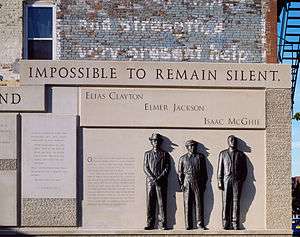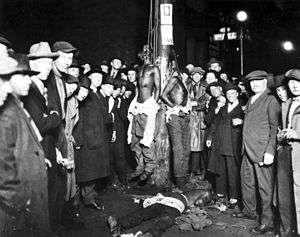1920 Duluth lynchings

The 1920 Duluth lynchings occurred on June 15, 1920, when three African American circus workers, Elias Clayton, Elmer Jackson, and Isaac McGhie were attacked and lynched by a mob in Duluth, Minnesota. Rumors had circulated that six African Americans had raped and robbed a teenage girl. A physician's examination subsequently found no evidence of rape or assault. The killings shocked the country, particularly for their occurrence in the northern United States, although four earlier lynchings had occurred in Minnesota.[1] Although a few convictions for crimes related to the events were obtained, no one was ever punished for the murders.
In 2003, the city of Duluth erected a memorial to the murdered men.[2]
Background
In September 1918, a Finnish immigrant named Olli Kinkkonen was lynched in Duluth, allegedly for dodging military service during World War I.[3] Kinkkonen was found dead, tarred and feathered, and hanging from a tree in Lester Park. Authorities did not pursue murder charges because they claimed that he had committed suicide after the shame of having been tarred and feathered.[3]
During and immediately following World War I, a large population of African Americans emigrated from the South to the North and Midwest in search of jobs. The predominantly white Midwest perceived the black migrant laborers as a threat to their employment, as well as to their ability to negotiate pay rates. U.S. Steel, for instance, the most important regional employer, addressed labor concerns by leveraging African-American laborers, migrants from the South.[4]
This racial antagonism erupted into race riots across the North and Midwest in 1919; this period of widespread flourishes of violence became known as the Red Summer of 1919. Even after the riots subsided, racial relations between blacks and whites remained strained and volatile.
Event

On June 14, 1920, the John Robinson Circus arrived in Duluth for a performance. Two local teenagers, Irene Tusken, age 19, and James ("Jimmie") Sullivan, 18, met at the circus and ended up behind the big top, watching the black workers dismantle the menagerie tent, load wagons and generally get the circus ready to move on. What actual events took place between Tusken, Sullivan and the workers are unknown; however, later that night Sullivan claimed that he and Tusken were assaulted, and Tusken was raped and robbed by five or six black circus workers.
In the early morning of June 15, Duluth Police Chief John Murphy received a call from James Sullivan’s father saying six black circus workers had held the pair at gunpoint and then raped and robbed Irene Tusken. John Murphy then lined up all 150 or so roustabouts, food service workers and props-men on the side of the tracks, and asked Sullivan and Tusken to identify their attackers. The police arrested six black men in connection with the rape and robbery.
The authenticity of Sullivan's rape claim is subject to skepticism. When Tusken was examined by her physician, Dr. David Graham, on the morning of June 15, he found no physical evidence of rape or assault.[5]
Newspapers printed articles on the alleged rape, while rumors spread throughout the town that Tusken had died as a result of the assault. Through the course of the day, a mob estimated between 1,000 and 10,000 people[5] formed outside the Duluth city jail and broke into the jail to beat and hang the accused. The Duluth Police, ordered not to use their guns, offered little or no resistance to the mob. They fought with their hands and fire hoses instead. The mob seized Elias Clayton, Elmer Jackson and Isaac McGhie and found them guilty of Tusken's rape in a sham trial. The three men were taken to 1st Street and 2nd Avenue East,[5] where they were beaten and hanged by the mob.
The next day the Minnesota National Guard arrived at Duluth to secure the area and to guard the surviving prisoners, as well as nine other men who were suspected. They were moved to the St. Louis County Jail under heavy guard.[5]
Aftermath
The killings made headlines throughout the whole country. The Chicago Evening Post opened, "This is a crime of a Northern state, as black and ugly as any that has brought the South in disrepute. The Duluth authorities stand condemned in the eyes of the nation." An article in the Minneapolis Journal accused the lynch mob of putting a "stain on the name of Minnesota," stating, "The sudden flaming up of racial passion, which is the reproach of the South, may also occur, as we now learn in the bitterness of humiliation in Minnesota."[5]
The June 15, 1920, Ely Miner reported that just across the bay in Superior, Wisconsin, the acting chief of police declared, "We are going to run all idle negroes out of Superior and they’re going to stay out." How many were forced out is not certain, but all of the blacks employed by a carnival in Superior were fired and told to leave the city.[5]
In its comprehensive website about the lynchings, the Minnesota State Historical Society reports the legal aftermath of the incident:
Two days later on June 17, 1920, Judge William Cant and the grand jury had a difficult time convicting the lead mob members. In the end the grand jury issued thirty-seven indictments for the lynching mob and twenty-five were given out for rioting and twelve for the crime of murder in the first degree. Some of the people were indicted for both. But only three people would end up being convicted for rioting. Seven men were indicted for rape. For five of the indicted men, charges were dismissed. The remaining two, Max Mason and William Miller, were tried for rape. William Miller was acquitted, while Max Mason was convicted and sentenced to serve seven to thirty years in prison.[5]
Mason served a prison sentence in Stillwater State Prison of only four years from 1921 to 1925 on the condition that he would leave the state.
No one was ever convicted for the murder of Isaac McGhie, Elmer Jackson and Elias Clayton.
Memorial
On October 10, 2003, the event was commemorated in Duluth, by dedicating a plaza including three seven-foot-tall bronze statues to the three men who were killed. The statues are part of a memorial across the street from the site of the lynchings. The Clayton Jackson McGhie Memorial was designed and sculpted by Carla J. Stetson, in collaboration with editor and writer Anthony Peyton-Porter.[6][7]
At the memorial's opening, thousands of citizens of Duluth and surrounding communities gathered for a ceremony. The final speaker at the ceremony was Warren Read, the great-grandson of one of the most prominent leaders of the lynch mob:
It was a long held family secret, and its deeply buried shame was brought to the surface and unraveled. We will never know the destinies and legacies these men would have chosen for themselves if they had been allowed to make that choice. But I know this: their existence, however brief and cruelly interrupted, is forever woven into the fabric of my own life. My son will continue to be raised in an environment of tolerance, understanding and humility, now with even more pertinence than before.|[4]
Read has written a memoir exploring his experiences with this discovery, as well his journey to find and connect with the descendants of Elmer Jackson, one of the men lynched that night. His book, The Lyncher in Me, was published by Borealis Books in March 2008.[8]
The white nationalist website VDARE wrote that the memorial was an attempt "to make whites feel ashamed of their race."[9]
Popular culture
The first verse of Bob Dylan's 1965 song "Desolation Row" recalls the lynchings in Duluth: They’re selling postcards of the hanging/ They’re painting the passports brown/ The beauty parlor is filled with sailors/ The circus is in town[10]
Dylan was born in Duluth, and grew up in Hibbing, which is 60 miles northwest of Duluth. His father, Abram Zimmerman, was nine years old in June 1920 and lived two blocks from the site of the lynchings.[11]
References
- ↑ Lynchings, by State and Race, 1882-1968, http://www.chesnuttarchive.org/classroom/lynchings_table_state.html
- ↑ Kraker, Dan. "Duluth marks anniversary of memorial to 3 lynching victims". www.mprnews.org. Retrieved 2016-02-19.
- 1 2 News.minnesota.publicradio.org
- 1 2 Duluth Lynchings: Presence of the Past. Twin Cities Public Television.
- 1 2 3 4 5 6 7 "Duluth Lynchings On line Resource". Minnesota Historical Society. Archived from the original on 21 February 2006. Retrieved 2006-03-09.
- ↑ Kelleher, Bob (June 8, 2003). "Lynching victims memorial takes shape in Duluth". Minnesota Public Radio. Retrieved November 3, 2012.
- ↑ "Creation of the Memorial". claytonjacksonmcghie.org. November 8, 2003. Retrieved November 3, 2012.
- ↑ Warren-read.com The Lyncher in Me; A Search for Redemption in the Face of History]. Read, Warren.
- ↑ Greil Marcus, Like A Rolling Stone: Bob Dylan at the Crossroads p28 publicaffairs, 2005
- ↑ Dylan, Bob. "Desolation Row". bobdylan.com. Retrieved June 2, 2014.
- ↑ Hoekstra, Dave (July 1, 2001). "Dylan's Duluth Faces Up to Its Past". Chicago Sun-Times. Retrieved May 29, 2014. See also: Polizzotti, Mark, Highway 61 Revisited, Continuum, 2006, ISBN 0-8264-1775-2, pp. 139-141
- Fedo, Michael (2000). The Lynchings in Duluth. St. Paul, MN: Minnesota Historical Society Press. ISBN 0-87351-386-X.
- Olsen, Ken. "Duluth Remembers 1920 Lynching". Fight Hate and Promote Tolerance. Tolerance.org. Archived from the original on 1 March 2006. Retrieved 2006-03-09.
External links
Coordinates: 46°47′22.25″N 92°05′48.54″W / 46.7895139°N 92.0968167°W